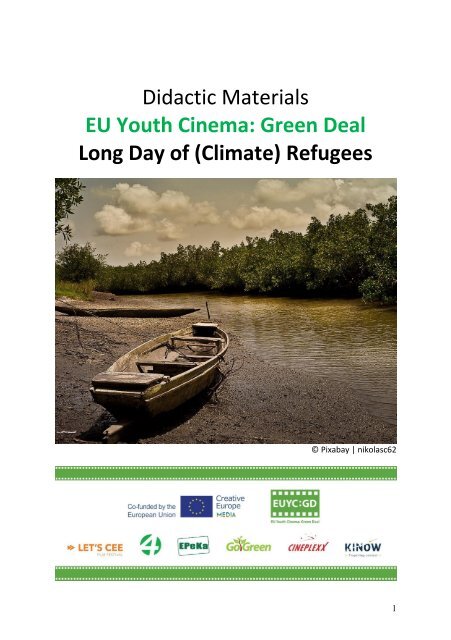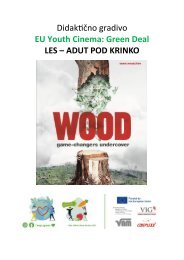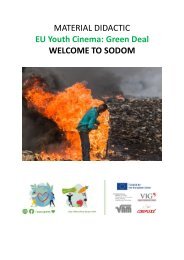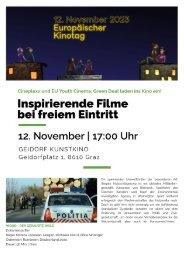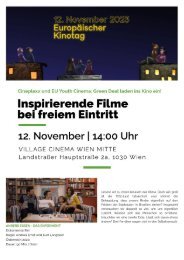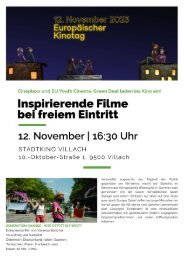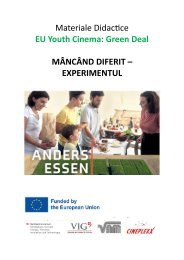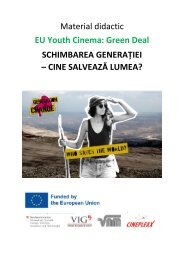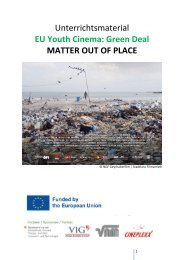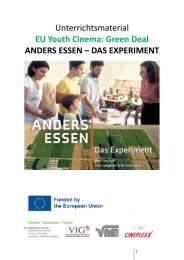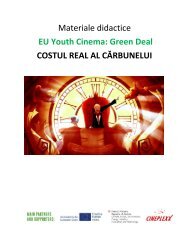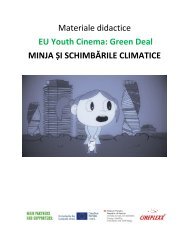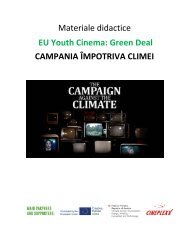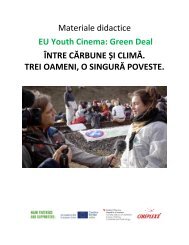LET'S CEE Film Festival Katalog 2017
Official Catalogue of the LET'S CEE Film Festival 2017
Official Catalogue of the LET'S CEE Film Festival 2017
Create successful ePaper yourself
Turn your PDF publications into a flip-book with our unique Google optimized e-Paper software.
Didactic Materials<br />
EU Youth Cinema: Green Deal<br />
Long Day of (Climate) Refugees<br />
© Pixabay | nikolasc62<br />
1
Table of Contents<br />
1. Climate Change and Flight ............................................................. 3<br />
1.1 What Does Climate Change and Flight have to do together? ................................... 3<br />
1.2 Who are environmental refugees? ............................................................................ 5<br />
1.3 Examples: How the climate crisis and flight are linked ............................................ 6<br />
2. <strong>Film</strong>: STOLEN FISH ...................................................................... 11<br />
2.1 Key facts and synopsis .............................................................................................. 11<br />
2.2 Protagonists .............................................................................................................. 12<br />
2.3 Director Gosia Juszczak ............................................................................................ 13<br />
2.4 The Gambia – key facts ............................................................................................ 15<br />
2.5 Fishmeal factories in Gambia ................................................................................... 16<br />
2
1. Climate Change and Flight<br />
1.1 What Does Climate Change and Flight have to do together?<br />
The world's climate is changing – at a rate that exceeds most scientists’ predictions. For many<br />
people, the negative consequences of climate change are already being felt firsthand. Many<br />
regions of the world are facing prolonged droughts; storms are on the rise. Millions of people<br />
live in the hotspots of climate change, but do not have the means to adapt to the increasingly<br />
inhospitable environment and difficult living conditions, or they leave their homes after a<br />
devastating natural disaster in search of a new start.<br />
Climate change threatens millions of lives<br />
Climate change, conflict, poverty, food insecurity, and displacement increasingly intersect,<br />
forcing more and more people to flee in search of safety. In this context, natural disasters<br />
trigger more than three times as many displacements as conflict and violence. According to<br />
the Internal Displacement Monitoring Centre (IDMC), UNHCR reports that some 23.7 million<br />
people were forced to leave their homes in 2021 due to natural events such as continuous<br />
rains, prolonged droughts, heat waves and storms, both short- and long-term.<br />
Info box<br />
“Climate change can enhance the competition for resources<br />
– water, food, grazing lands – and that competition can trigger<br />
conflict.” – António Guterres, then High Commissioner<br />
for Refugees and current UN-Secretary-General, at the<br />
World Climate Summit in Copenhagen in 2009.<br />
© Photo and Biography | United Nations Secretary-General<br />
The UN Refugee Agency has summarized the issue of climate and flight in a 60-second<br />
video that can be shown in class. Video on YouTube:
In almost every natural disaster – whether landslides, floods, typhoons or hurricanes – people<br />
have to flee their homes, sometimes even across national borders.<br />
Countries of origin and host countries overwhelmed by climate change impacts<br />
80% of refugees come from poor, crisis-ridden countries that are affected by climate change,<br />
but have few resources to prevent or mitigate its impacts. These include the five countries<br />
with the highest number of refugees worldwide: Syria, Venezuela, Afghanistan, South Sudan,<br />
and Myanmar. Most people forced to flee in the context of climate change and natural disasters<br />
remain in their own countries. 40% of the refugees live in countries that are particularly<br />
affected by climate change.<br />
Climate change harbors conflict potential<br />
Limited natural resources, such as drinking water, will become even scarcer in the future.<br />
Many crops and some livestock species will not be able to survive in certain areas if it becomes<br />
too hot and dry or too cold and wet. Food supply is already a concern in many regions of the<br />
world. People will have to try to adapt to this situation, but for many it will mean deliberately<br />
moving to another region to survive. The situation is also fueling a potential for conflict between<br />
communities as more and more people have to compete for fewer and fewer resources.<br />
Source:
1.2 Who are environmental refugees?<br />
The link between environmental problems and migration is obvious, because it is conveyed<br />
at first hand by shocking images of people fleeing floods, for example. Yet the connections<br />
are indeed very complex. Overall, the reasons why people have to leave their familiar surroundings<br />
and become refugees involve a mixture of political, social, cultural or religious factors.<br />
Often, of course, environmental problems also play an important role. However, the<br />
triggering "push factors" cannot be reduced to a single reason.<br />
Among the refugees and migrant workers, there are of course also people who have had to<br />
leave their homes because of environmental damage. But what should we call them now?<br />
Water refugees, climate refugees, climate migrants, environmental refugees, environmental<br />
migration, climate-induced migration – these are just some of the terms that come up in this<br />
context. There is no uniform interpretation or even internationally recognized definition.<br />
Some experts advocate replacing the indeed woolly and misleading term "environmental refugees"<br />
with "disaster refugees". But even this term leads to misunderstandings, because not<br />
all people who fall into this category have to leave their homes because of disasters such as<br />
volcanic eruptions or floods. No wonder, then, that there is no reliable data on environmentally<br />
induced flight, in contrast to labor migrants and "UNHCR refugees". The term "environmental<br />
refugees" was introduced in 1985 by the natural scientist Essam El-Hinnawi in his report<br />
for the United Nations Environment Programme (UNEP).<br />
Source:
Do environmental refugees enjoy special protection?<br />
The "Convention relating to the Status of Refugees" – the official title of the Geneva Refugee<br />
Convention (GRC) – of 1951 and the supplementary protocol of 1967 are referred to as the<br />
"Magna Charta" of refugees and remain the most important international documents for the<br />
protection of refugees to this day. The Convention defines who is a refugee and what protection,<br />
but also what obligations go along with it.<br />
Article 33 contains the prohibition to expel or return a refugee "in any manner whatsoever<br />
beyond the frontiers of territories where his life or freedom would be threatened on account<br />
of his race, religion, nationality, membership of a particular social group or political opinion."<br />
According to Article 1 A of the Geneva Convention, a refugee is a person who "owing to a<br />
well-founded fear of being persecuted for reasons of race, religion, nationality, membership<br />
of a particular social group or political opinion, is outside the country of his nationality and is<br />
unable or, owing to such fear, is unwilling to avail himself of the protection of that country".<br />
People who are forced to leave their homes due to climate change and environmental disasters<br />
are not covered by the Geneva Refugee Convention and therefore do not fall under the<br />
protection of the United Nations Refugee Agency (UNHCR). As long as they remain in their<br />
own country as internally displaced persons, their home country supports them and they are<br />
subject to the laws applicable there. But when they cross national borders, there is a protection<br />
gap.<br />
Source: Klimaflucht und Umweltflüchtlinge. Ein LpB-Dossier (lpb-bw.de) (in German)<br />
1.3 Examples: How the climate crisis and flight are linked<br />
When natural disasters, conflicts and displacement come together, the effects are devastating.<br />
The consequences of climate change affect us all – but refugees are particularly vulnerable.<br />
Three stories from Nicaragua, Afghanistan and Niger make it shockingly clear:<br />
Nicaragua: Unpredictable weather, political consequences<br />
Until two years ago, David Cruz owned his own land in Nicaragua, where he raised cattle and<br />
chickens and grew tomatoes and chilies. But this way of life was threatened even before his<br />
involvement in the protests made him a target of political persecution. Over the years, the<br />
climate in his region of Nicaragua had become drier and more unpredictable. When it rained,<br />
it was often torrential, damaging David's crops. "My crops were failing," he says. "And because<br />
the authorities had basically declared me the 'enemy,' they made it impossible for me<br />
to get loans I needed to replant." Climate change alone didn't force David to abandon his farm<br />
and flee to Costa Rica, but for him and a growing number of people around the world, it<br />
played an instrumental role in his escape.<br />
6
24.9 million climate-related displaced people in 2019<br />
© Cattle during the dry season in Nicaragua (wikimedia.org)<br />
In 2019, weather-related hazards triggered some 24.9 million displacements in 140 countries<br />
around the world. Most climate change-related displacement occurs within national borders.<br />
People fleeing extreme weather events such as hurricanes, cyclones, and floods tend to stay<br />
as close to home as possible and return when the floodwaters have receded. Climate change<br />
amplifies the effects of other threats that lead to displacement – worsening poverty and pressuring<br />
resources and governance – in ways that can fuel conflict and violence.<br />
Afghanistan: Shrinking snowmelt, growing insecurity<br />
The link between climate change and insecurity is also evident in Afghanistan, where steadily<br />
rising temperatures are leading to changing rainfall and snowmelt patterns and an increased<br />
risk of flash floods. In 2018, a drought reduced the livelihoods of tens of thousands of households<br />
in the country's rural northwest.<br />
Ghulam Sakhi, 45, and his family lived in a mountainous region in Ghor province, where they<br />
relied on winter rains and snow to fill their well, cultivate their land and grow grass for their<br />
animals. When the rain and snow failed three years ago, "we lost everything," he says. "We<br />
sold our animals for a third or a quarter of their price. When the money ran out, we had no<br />
choice, but to go somewhere where we could earn a living." For the past two and a half years,<br />
Ghulam and his family have been living in makeshift housing in a camp for internally displaced<br />
people south of Herat city, where they rely on humanitarian aid.<br />
In the meantime, insecurity in their home region has worsened, further diminishing prospects<br />
of returning. "When I lived there, the security situation was not good, there was drought and<br />
there was the Taliban. But now there are more Taliban and they are better armed," Ghulam<br />
says. "I pray to God for peace so that my children can study and feel safe and comfortable."<br />
7
The warming of the world climate has uneven effects<br />
© Children in Central Afghanistan (wikimedia.org)<br />
The most vulnerable people in some of the most vulnerable and conflict-affected countries<br />
are suffering the most severe impacts, ranging from worsening droughts to flooding. From<br />
Nicaragua to Niger, people in rural areas struggle to grow the crops that used to feed their<br />
families or find pasture for their animals. The search for greener pastures exposes them to<br />
new risks when they move to urban areas, sometimes bringing them into conflict with others.<br />
Niger: Drought and conflict<br />
© Settlement in Niger (wikimedia.org)<br />
8
After more than a decade of watching his herd of cattle dwindle due to irregular rains and<br />
drought in southwestern Niger, Djouba Fedou, 60, began herding them out of his village near<br />
the border with Mali to other areas where they could graze. But his animals now crossed<br />
farmland and sometimes trampled other local farmers’ crops. "The authorities sometimes<br />
called me weekly because cattle were found in farmers’ fields and I had to pay money for<br />
them," he says. "Sometimes I even sold cows to pay fines and free myself and my children."<br />
By the time the violent insurgency from neighboring Mali and Burkina Faso reached Djouba’s<br />
village, he had already abandoned cattle ranching. He fled with his two wives and ten children<br />
to a camp in Niger, where Nigerien internally displaced people live alongside refugees from<br />
Mali. There they were given shelter and food, but without his cattle, Djouba has little hope of<br />
returning to a self-sufficient life, being able to feed his family.<br />
The Sahel: Most affected by climate change<br />
The Sahel is one of the regions of the world most affected by climate change. Temperatures<br />
in the region are rising 1.5 times faster than the global average. While rainy seasons are getting<br />
shorter and dry seasons longer, the population is growing rapidly and more and more<br />
land is being used for agriculture, leaving less and less land for herders like Djouba.<br />
Land and water disputes between farmers and pastoralists are being exploited by extremist<br />
organizations seeking a foothold in the region. The central Sahel countries of Niger, Mali, and<br />
Burkina Faso are now at the epicenter of one of the fastest growing displacement crises in<br />
the world, with nearly 1.6 million internally displaced people and 365,000 refugees fleeing<br />
violence, including over 640,000 this year alone.<br />
Fast action required<br />
When people flee their homes or even cross borders, they are not necessarily safe, whether<br />
from the effects of climate change or other factors. In Afghanistan, Ghulam's family lives on<br />
a plot of land that floods with water every winter, causing their shelter to collapse. This winter<br />
will be especially hard, as the COVID-19 pandemic has deprived the family of what little income<br />
the older children earned from casual labor.<br />
In Niger, the town of Intikane, where Djouba and his family sought shelter, was attacked earlier<br />
this year by 50 armed men on motorcycles. Three people were killed, and Djouba was<br />
among the thousands of refugees and internally displaced people who were temporarily<br />
forced to flee again. After months of odd jobs in Costa Rica, David had just found a steady job<br />
as a security guard when the economy crashed and he was laid off. Now he is months behind<br />
on his rent.<br />
In response to such challenges, UNHCR is stepping up its efforts to protect people like David,<br />
Djouba, and Ghulam. As part of a strategic framework for climate action to be developed in<br />
2020, UNHCR is reviewing existing international and regional laws and agreements on the<br />
protection of displaced persons to see how they can be applied to those displaced due to<br />
climate change.<br />
9
Climate change is the biggest crisis of our time and hits refugees particularly hard<br />
UNHCR also seeks to improve the resilience of displaced people to climate and other environmental<br />
risks, for example, by ensuring that refugee shelters are established in safe, sustainable<br />
locations and by mitigating environmental degradation through reforestation and other<br />
measures. The refugee agency is also committed to reducing its own greenhouse gas emissions<br />
and minimizing the negative impact of its operations on the environment. One focus<br />
will be on switching to sustainable and preferably renewable energy sources.<br />
While the COVID-19 pandemic has made people already struggling with the impacts of climate<br />
change, insecurity, and displacement even more vulnerable, the concerted global response<br />
can provide some important lessons for addressing these new challenges, according to Andrew<br />
Harper, UNHCR's special representative for climate policy: "It shows that if we want to<br />
mitigate the impacts of a disaster, we have to be prepared to act quickly and holistically. If<br />
we ignore this, we will face serious consequences."<br />
Source: So hängen Klimakrise und Flucht zusammen (uno-fluechtlingshilfe.de) (in German)<br />
Task<br />
The examples from countries such as Afghanistan, Niger or Nicaragua can be read and discussed<br />
together in class. What scope for action do the individual people described have?<br />
1. Discussion: As mentioned above, 80% of all refugees come from poor crisis-ridden<br />
countries, that are affected by climate change, but have no resources to prevent or<br />
mitigate the consequences. Discuss the following questions:<br />
- What can individuals, companies and states do in order to support countries especially<br />
hit by climate change?<br />
- Who should be particularly active when it comes to supporting these countries, and<br />
what can this support look like?<br />
10
2. <strong>Film</strong>: STOLEN FISH<br />
2.1 Key facts and synopsis<br />
Documentary STOLEN FISH<br />
Original title: KIEDY ZABRAKNIE RYB<br />
Director/Writer/Producer: Gosia Juszczak<br />
Countries of origin: United Kingdom, Poland 2021<br />
Languages: Chinese, Afrikaans, English<br />
Length: 30 min<br />
Production companies: Minority Rights Group International, Compassion in World Farming,<br />
Rosa Luxemburg Stiftung<br />
Age recommendation: from 10 years up<br />
Synopsis<br />
© Stolen Fish - Vimeo<br />
Africa's smallest country, The Gambia, is running out of fish. Since Chinese fish-meal factories<br />
have appeared there, most of it is processed into animal feed and shipped to China and Europe.<br />
Despite the protests, the big neocolonial business is flourishing, and the promises of<br />
new roads and hundreds of jobs are turning out to be a deceptive mirage. The stories of fishermen<br />
Paul and Abou and fish seller Mariam provide an intimate frame for the story of West<br />
Africa's stolen development and the compulsion to seek a better life in Europe. It is the first<br />
film about the fish-meal factories in The Gambia, offering a unique insight into the unspeakable<br />
drivers of migration.<br />
Music<br />
The film features ST Gambian Dream’s song FUWAREYAA which provides context for the story<br />
told from within and in Mandinka language.<br />
11
Clip: S T Gambian Dream - FUWAREYAA (Official Video) - YouTube<br />
2.2 Protagonists<br />
Paul<br />
STOLEN FISH – scene with Paul:<br />
https://vimeo.com/753536512/495feb5bfd<br />
Abou<br />
STOLEN FISH – scene with Abou:<br />
https://vimeo.com/753536984/0ca79bf5c8<br />
Paul experienced a difficult path of escape<br />
and return – a story of migration<br />
which he still carries on his shoulders.<br />
Paul: “Twenty-two people were<br />
squeezed in a 3-metre cell. Children, elderly,<br />
even pregnant women. All with the<br />
intention to go to Europe.”<br />
Abou is a fisherman in Bakau. Although<br />
the city is free from Chinese factories,<br />
their activity is strongly felt here. Every<br />
night Abou observes Chinese ships in the<br />
ocean, also during the day when he sets<br />
out to sea with his small wooden boat.<br />
Frustration and fear become part of his<br />
daily life. Abou: “In Gambia, the Chinese<br />
have more rights than we do. Because of<br />
the money. They give money to the government.<br />
But we don’t see it, we don’t<br />
know where that money goes.”<br />
12
Mariama<br />
STOLEN FISH – scene with Mariama:<br />
https://vimeo.com/753537400/56c15d29b7<br />
Like many women, Mariama earns her<br />
living from smoking and selling fish. It's<br />
exhausting work. Hours of waiting for<br />
the boat in the sun, carrying heavy buckets,<br />
inhaling smoke. Mariama is a conscious<br />
activist. She raises awareness of<br />
those who focus on short-term benefits.<br />
Mariama: “They give us sickness that we<br />
don’t understand. If I could talk to the<br />
factory owner, I would tell them to<br />
leave.”<br />
Task<br />
Discuss the actions and goals of three main protagonists. What do they have in common,<br />
what do they differ from?<br />
2.3 Director Gosia Juszczak<br />
The Polish director Gosia Juszczak (born 1981),<br />
who lives in Madrid, is a graduate of the Andrzej<br />
Wajda <strong>Film</strong> School in Warsaw. In her work, Gosia<br />
focuses on minorities, migration and borders.<br />
She directed a series of mini docs, such as “The<br />
Cargo Women of Melilla”, a take on a slave-like<br />
work of Moroccan women on the Southern EU<br />
border or “The Bitter Fruit of Andalucia” which<br />
sheds light on the migrant work in greenhouses<br />
supplying fruit and vegetables to the European<br />
markets. STOLEN FISH is her mid-length debut.<br />
This award-winning documentary was highlighted<br />
by VICE Magazine as one of the ten most<br />
radical films of the Sheffield Doc/Fest in the<br />
United Kingdom.<br />
Gosia is also a journalist, translator and speaker. She has written about unnoticed issues such<br />
as the displacement of Kenya's Sengwer community and the struggle of the Nubian minority<br />
in Kenya. She writes regularly for Le Monde diplomatique and Novara Media, where she publishes<br />
human rights stories such as "Cargo Women of Melilla", about the slave-like labor of<br />
Moroccan women on the southern EU border. She is also a former human rights observer in<br />
the Middle East and co-author of the book All Quiet in the West Bank.<br />
13
Gosia’s further projects: https://storyhunter.com/gosia-juszczak.<br />
Director’s note:<br />
I’ll be honest – my interest in this topic was unplanned. When a Gambian activist, friend of a<br />
friend, told me about the fishmeal factories over a drink, I never thought our conversation<br />
would take us to the production of a film. But there are no coincidences in life, right?<br />
As someone living in Madrid’s increasingly gentrified neighborhood of Lavapiés, an area frequented<br />
by West African migrants and an epicenter of Spanish antiracist movements, engaging<br />
within this network was an obvious step for me. Three years ago a Senegalese street vendor<br />
died after being chased by the police and refused access to the ambulance. His only crime<br />
had been trying to make a living by selling clothes on the street. Protests quickly turned into<br />
riots. “These people are our neighbors! You’re murderers!”, people would shout at the police.<br />
Back then we highlighted the absurdity of Spanish immigration law forbidding people from<br />
working for three years before applying for a legal stay in the country. The story of Gambia’s<br />
fishmeal plants and its impact on local populations seemed to be a distant and unconnected<br />
topic at the time.<br />
And yet the two topics are inherently connected. Gambia is a “perfect” example of the neocolonial<br />
exploitation of resources, which in the long run forces people to migrate. This smallest<br />
inland African country, one of the last ones to gain independence from the British rule and<br />
still healing wounds from a brutal 22-year dictatorship, is now facing another issue: a threat<br />
to its food security.<br />
The more we dove into our research, the “smiling coast” – as Gambians call their country –<br />
seemed to lose its smile. We wanted to understand the issue first hand and this could only be<br />
done with a participatory approach: living inside the community, being close to the people.<br />
Also, despite a tight budget, we had a Gambia expert on the team and worked closely with<br />
Gambian activists. And we were in no rush: hours-long conversations over attaya tea, weeks<br />
spent in people’s homes, fishing ports and villages, before we even started shooting. Many<br />
joyful moments, as well as challenges. But most importantly, we met courageous people who<br />
let us into their lives and shared some very tough experiences.<br />
Although Chinese presence and so called “investments” in Africa are already well known to<br />
the wider public, this specific activity – fishmeal production from the whole fish fit for human<br />
consumption – also concerns us Europeans. More research is still needed to trace the way<br />
fish is taken away from the Gambians to end up on our plates in Europe or elsewhere in the<br />
form of a hamburger or artificially farmed fish. This film is a way of raising awareness, but also<br />
a mirror for us Europeans. Our consumption choices do influence economies hundreds of<br />
miles away. The world is slowly realizing that globalization comes with responsibility. While<br />
eating chicken wings one should ponder if it could be fed with fish stolen from The Gambia.<br />
“It is quite naive to think that your hamburger can come at such a ridiculously low price”, said<br />
one of our interviewees.<br />
The film depicts an emerging problem, not yet thoroughly studied or covered. Although operating<br />
for only approximately three years now, the factories activity already brought<br />
14
disastrous consequences: to the environment, to the social fabric, to local economy, including<br />
to the tourist industry which accounts for 30% of the GDP of this poor country. The problem<br />
is already being reflected in local art and music – ST, a popular Gambian rapper, used his<br />
music to underline the root causes of poverty and migration, specifically targeting the Chinese<br />
factory in Gunjur. His song sets the background for the culminating scene of the documentary<br />
– a voice from within about a problem that is getting out of hand.<br />
The factories are being protested against and challenged in court by local activists who call<br />
for the much-needed international support. This topic is gaining momentum – the time to<br />
show this movie is now! As a first narrative piece on this particular topic it will hopefully tool<br />
for Gambians and other West African nations that oppose the grab of resources and spark<br />
discussion amongst Europeans and raise questions about our consumption models.<br />
This film is only 30 minutes long – way too short to convey all my reflections, lessons learnt<br />
and nuances of what migration means to the Gambians, but getting to know the families that<br />
put hope in their sons who migrate with a dream of uplifting their families from poverty<br />
changed my perspective. The individual stories shown in the film are ultimately a reflection<br />
of a collective experience, and they are not that far from us – they converge in European<br />
squares and streets. After coming back from The Gambia, neighbors I say hello to in a local<br />
bar suddenly became much more than that, I could relate to their pain of separation and<br />
frustration.<br />
2.4 The Gambia – key facts<br />
Info box<br />
State: The Gambia<br />
Capital: Banjul<br />
Currency: Dalasi (GMD)<br />
Official Language: Englisch<br />
Population.000 (2021)<br />
Landsurface in km 2 : 11.300<br />
National flag<br />
15
Task<br />
Research on The Gambia: The students should research information on The Gambia either<br />
at home or in class. The information can then be compiled in class and, if necessary, visually<br />
prepared.<br />
2.5 Fishmeal factories in Gambia<br />
Fishmeal factories in Gambia: a new driver for migration?<br />
By Sanam Monteiro, Communications Intern at Minority Rights Group International<br />
Amid the unfolding climate crisis, hostile migration policies and growing inequality worldwide,<br />
writer and director Gosia Juszczak explores the root causes of the increasingly desperate<br />
migration from the shores of Gambia.<br />
Gambia, is not just the smallest country in mainland Africa but it is also among the poorest of<br />
the continent. Gambians are now facing a new kind of threat: Chinese fishmeal factories. In a<br />
threefold narrative following the lives of Abou, Mariama and Paul, the film explores the impact<br />
of new factories on the lives of local people.<br />
Many have heard about Chinese investments in Africa yet few really know what type of investments<br />
they actually are. In Gambia, they are not hard to miss: fishmeal plants have sprung<br />
up along its short coastline. While initially these plants promised big economic benefits for<br />
locals, they have achieved the opposite. The fishmeal plants and the industrial fishing vessels<br />
that are supplying them have destroyed the fragile coastal marine ecosystem, depriving local<br />
residents of their only supply of protein.<br />
This has undermined the social fabric and severely affected the tourism industry, which is<br />
the
the decline of fish in the sea and the huge spike in waterborne diseases. Her livelihood, similarly<br />
to most Gambians, depends on resources from the sea.<br />
As Abu rightly points out, drawing with a stick on the sand, The Gambia is only a small stretch<br />
of land along the river after which it is named. There is no space for growing crops or farming<br />
animals so most of the country relies on fish.<br />
Having always coexisted with the river, locals know that the river delta is where fish reproduce.<br />
Since the new fishmeal factories appeared, very few fish make it all the way to the river<br />
delta, putting people’s livelihood at great risk.<br />
These intimate stories from Abou, Mariama and Paul show broad issues at play on the local<br />
level. They show the impact of unregulated investment on human rights, the drivers of migration<br />
and the role played by women in new economic systems. It’s dangerous and dehumanizing<br />
to reduce migrants to numbers and graphs. Every human has a story that drives<br />
their decision.<br />
The growth in Western consumption models create a demand for exploitative businesses<br />
such as the fishmeal factories. From the fishermen of The Gambia to the
Imprint<br />
Editors:<br />
Dr. Tobias Spöri, Dr. Magdalena Żelasko<br />
Proofreading: Gloria Dimmel<br />
----<br />
EU Youth Cinema: Green Deal<br />
General Coordinator:<br />
Association LET’S <strong>CEE</strong> <strong>Film</strong>festival<br />
Mommsengasse 6/17<br />
1040 Vienna<br />
Central Register of Associations: 024642345<br />
18


